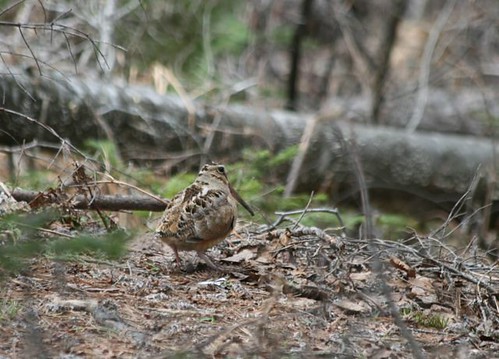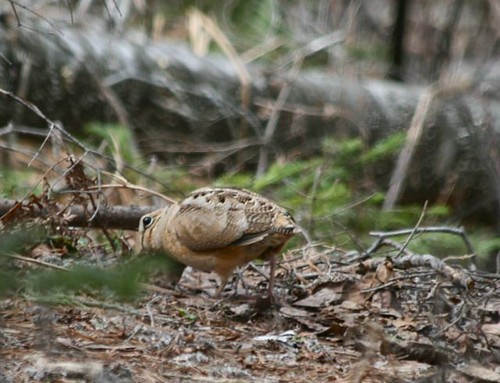.

When they're aware of being watched, woodcocks do a little deep-knee bend that is utterly charming. They bob and weave, perhaps making themselves even harder to detect as they putter along. This could also help camouflage them from the prey they're hunting, making them look like part of the moving foliage overhead. But then, do earthworms have eyes? So much for that theory...I suppose some of the woodcock's prey has eyes.
I don't think anyone really knows why woodcocks do constant plie's (I have no idea how to spell that, and am too lazy to begin to know how to look it up) while they work. While I was at the Cornell Lab of Ornithology, a woodcock dropped into a moist section of Sapsucker Woods and entertained hundreds of people over the course of the week (I missed it, unfortunately). The main topic of discussion among the ornithologists was the bob and weave behavior of the bird. It's impossible to know whether the bird would do this if we weren't looking at it; it's one of those "if a tree fell in the forest with no one to hear it" questions. ** You're looking at it; it's bobbing; would it bob if you weren't looking at it? I tend to err on the side of giving the bird credit for being supremely aware that it's being watched, and for altering its behavior while being observed, no matter how calm and nonchalant it seems.
**A permutation of that concept that I like is, "If a man made a statement in the middle of a forest without a woman to hear him, would he still be wrong?"
I don't know why I said that. This is a bird post.

As I watched, the woodcock foraged. Note the very high placement of its eyes. The woodcock has the largest field of vision of any North American bird, almost 360 degrees without turning its head, with very narrow blind spots directly in front of its forehead and at the back of its head. Imagine being able to see a panorama all the way around you. That's got to come in handy when you've got your bill stuck deep in the mud, feeling around for earthworms. It's also probably great for keeping watch on your rivals as you all display together in a meadow.
Its bill is also very cool. The woodcock can insert the bill up to its hilt in the earth, and, without opening it, grab a worm. How? It has a tendon running along the upper ridge (the culmen) of the upper bill (maxilla) that, when contracted, pulls open just the tip of the upper bill. If you're ever lucky enough to have a road-killed woodcock in the hand, try playing with its bill. I have. It's like a miniature can grabber. Obviously, it works. Slurrp!

I often wonder what woodcocks ate before the colonists brought their earthworms to the New World. And I'm still wondering about that guy, standing out in the middle of the forest.
This brings to a wormy end the posts about the Upper Peninsula. I truly hope to get back sometime when I don't have to rush right off somewhere else. It is a magical place, and it makes me want to get in my canoe and paddle off to see what I can see. Still can't believe I saw a wolf there.






18 comments:
I learn so very much from you. I like the can-grabber description. What an interesting bird.
I would like to go to the UP some day. I haven't been there since I was a kiddo.
Of course he'd still be wrong.
I'd love to see a woodcock - cool bird. I'm so glad you have your camera with you most of the time. I never know what I'll find here when I visit.
Mary
"If a man made a statement in the middle of a forest without a woman to hear him, would he still be wrong?"
lol! I've read that before but it still kills me.
I learn so much from your posts. I guess with almost 360 vision, it would be tough for a woodcock *not* to know you were watching it. I hope I get to see one someday, and that it bobs for me :)
Yes indeed, he'd be wrong. ;c)
Very neat bird, that woodcock.
Da Laydeez is gangin' up on da men. Warning, bloggrrls. Though it appears that this is a chickblog, there are men lurking here. I have seen their tracks and scat, though they are as elusive as wolves.
Tim, Mojo, Monarch, both of you other guys... stand up for your rights.
Science, humor, non-sequiturs, and pics of a dapper gentleman all in one post... doesn't get any better than this.
Cyberthrush, a thousand apologies for excluding you from the male roll call. You have opposable thumbs and I unthinkingly grouped you in with the more loquacious half. ;-P
What great photos! In Alabama the woodcocks are here in the wintertime. We see thier crazy spiral-y flights in January (or usually, hear them). In February I almost had several heart attacks when they saw me before I saw them... they flush rather explosively!
I am still trying to see my first woodcock, but now I know a lot more about them! Thanks.
My friend Boneman left this comment:
Still not having any luck getting Blogger to accept my comments. The wonderful weirdness of woodcock skulls goes deeper than just being able to manipulate the tip of their beak. The maxilla (unlike any other bird I know) never fuses, with the result that the two halves are just held in place by the keratin sheath of the rhamphotheca. It looks like a tuning fork and I have wondered if it might not work like a tuning fork to detect vibrations of prey.
Zick back again: How cool is that? So you've got two long thin bones running down the woodcock's upper bill, not connected, just held together by the soft skin of the ramphotheca. What a lovely thought, that it acts like a tuning fork, transferring minute vibrations up the bill.Thanks, Boneman! I see you're above the "man in the forest" fray.
And from a friend (also male! Yip! Yip!) in PA who can't comment on Blogger:
Great pictures of the Woodcock! Whoop Whoop!
Praying Mantis also does a head bob thing that is related to distance
estimation (cf: VISUAL DISTANCE DISCRIMINATION BETWEEN STATIONARY TARGETS
IN
PRAYING MANTIS: AN INDEX OF THE USE OF MOTION PARALLAX
http://jeb.biologists.org/cgi/
reprint/198/10/2127.pdf
Perhaps Mr. WC is just trying to make sure you are too far away to pounce.
before he can spring.
Also head-bobbing in reptiles may be related to distance estimation:
"Many agamids and iguanids "head-bob"when other lizards approach their
territories, and hcad-bobbing has also been described in the Australian
skinks Eulamprus kosciusko(Done and Heatwole, l977a) and Egernia inornata (Webber, l97B)' although without interpretation. If this behaviour does
increase visual acuity, the head-bob display seen in agamids and iguanids
may have arisen as a means of gaining better visual information about intruders into an animal's territory."
http://www.bio.usyd.edu.au/
Shinelab/publications/reprints/
118ethogramguich.pdf
Lucky, lucky you are to have gotten pictures. I love the dance in the air, and the sound when it lands. A delightful bird all around.
If you've nothing better to do, please read this little dissertation on the woodcock's brain, eye placement, and skull.
http://elibrary.unm.edu/sora/
Auk/v076n01/p0055-p0059.html
I love it. Here's this guy who goes out and shoots three woodcocks,a semipalmated plover, a short-billed dowitcher, a semipalmated sandpiper, and three herring gulls. He removes their skulls, piece by piece, and notes the angle of their brains and the eye placement relative to the brain. He's figuring it out, how the woodcock's crazy eye placement might have evolved. And you wonder what ornithologists do all day.
Okay Julie, you’ve brought another “male” out of the wood-work…
Maybe the “bob and weaving” behavior is a male trying to convince his female counterpart that he is not wrong, but actually right! …and the argument was - Male birds ARE more attractive than female birds!!
Hee, hee…
Great post by the way!
Alan
Can grabbers and tuning forks. I really am smitten with the idea of the prey-detection feature of the tuning fork maxilla.
And I am not picking on da mens.
From one of my most brilliantest (male) friends--who happens to be right most of the time whether he's in the middle of the woods or standing next to his wife--also my U.P. authority, also a lurker:
Not to nitpick at your lovely ode to the woodcock, and I claim no expertise on the subject of earthworms...BUT. I've read the assertion many times that there were no native North American earthworms, and that every earthworm presently here is a Eurasian import. This never made any sense to me. Why would this be the case? Earthworms, I would think, certainly evolved before plate tectonics produced the split in the land masses. Why would none exist in North America, but be present in Eurasia?
This once perplexed me to the point where I did some research, and I discovered that earthworm species deemed to be native to NA outnumber the imports. It is true, I think, that earthworms were historically absent or present only in low numbers in parts of the upper Midwest and Northeast. My guess is that this resulted from the fact that portions of those regions were in fact scraped down to bedrock, probably eliminating endemic earthworms in those areas. Worms are necessarily very slow colonizers without humans to move them around. This, together with an acid reaction and thin soils not overly hospitable to worms, probably kept the populations very low.
Anyway, I suspect that so long as the woodcock has graced our land, there have been earthworms present for its dining pleasure, though the availablity of that meal would have varied by geographic region. Just my take on the great earthworm controversy.
Zick here--Dang, this is fun. Who knew there'd be so many men out there, all of 'em right for once?
"Cyberthrush, a thousand apologies for excluding you from the male roll call..."
no apology required (I never apologize when I get lost and refuse to ask for directions); I'm just embarrassed though to discover that all along I've been reading a 'chickblog!' 8-?
Women, wise that they are, wouldn't waste their time making a statement in the forest. Knowing perfectly well that the forest wouldn't provide the answer to that age old question, "does this dress make me look fat."
Post a Comment